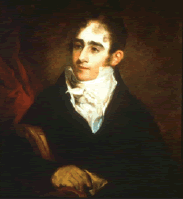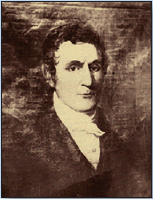
|

Summer 2006 CourierCrime and Punishment at Fort Norfolk in 1814In the first year of the War of 1812, the Untied States made three attempts to invade Canada. Although each was a failure, the repeated incursions convinced the government in London to send a fleet to the Chesapeake to take pressure off the Canadian frontier. In December 1812, Admiral Warren, the commander of the Royal Navy American and West Indies Station, was ordered to focus his 25-ship force on the Bay. The first of his ships arrived within the Virginia Capes in February 1813. This in turn caused a call-up of Virginia militia units. Thickening the plot was the presence of the U.S. frigate Constellation The potential danger represented in the proximity of the British fleet caused most militia volunteers to extend their service at the end of their six-month term in September 1813. General Robert B. Taylor, who commanded the Norfolk district, worked hard to enforce discipline and keep his militia units alert. Garrison duty became increasingly dull, however, as the British made no further movement towards Norfolk. As the end of the second period of enlistment approached, boredom and alcohol began to take the edge off the sword.
Among the Moses Myers Family Papers held by the Chrysler Museum of Art, is a sixteen-page manuscript draft of the records of ten courts-martial held at Fort Norfolk between February 27th and March 4th, 1814. The draft was written by John Myers, eldest son of Norfolk merchant Moses Myers. John had been aide-de-camp to General Taylor until that worthy’s leaving the service on February 6, 1814 whereupon Captain Myers took command of a company of the line of the 5th Virginia Regiment. The regiment was camped in Colley’s Peach Orchard near Fort Norfolk. It manned outlying posts at Fort Barbour (near present day Church Street and Princess Anne Road) and at Fort Tar (Monticello Avenue and Virginia Beach Boulevard). John Myers shared a hut in the Peach Orchard with the regiment’s deputy commander, Lt. Colonel Richard E. Parker of Westmoreland County. As time for the 5th Regiment’s discharge approached, a general court martial board was formed to clear the punishment books. The board consisted of Lt. Colonel Parker as President, Captain James Meek, Captain Bibb, Lieutenant Lindsay, Ensign Capron and Ensign George Boxley as members. Captain Myers served as Judge Advocate. The court met in the quarters of Col. Parker each day at 10 o’clock in the morning. The charges of those tried were of varying degrees of severity as were the resultant punishments.
Of the ten cases tried, half were for Sleeping on Post”. This discrepancy was apparently so prevalent in part because Officers of the Guard were not enforcing the requirement for sentinels to stand while on guard. Once a tired or bored soldier sat down it didn’t take long for them to nod off. From testimony, it appears that the most convincing piece of evidence was the fact that the reporting sergeant or officer was able to take the prisoner’s gun without awakening him. Three of the five soldiers so charged were found guilty. Two, Privates James Patten and Thomas Manson, were sentenced to wear a ball and chain for one hour for two days and then to perform extra duty for the balance of their tour of service. The third guilty offender, Rueben Finley, was sentenced to “ride a cannon for 2 hours, with his hands tied behind him & feet together & labour for the balance of his service.” Two prisoners were not convicted on this charge. In James English’s case the only witness had enlisted in the Regular Army and was not available to testify. There was sufficient doubt in the case of Private George Leonard for him to receive the verdict “Not Proved”. Private Thomas McGee of Captain Shelton’s Company was charged with “Leaving his Post”. McGee admitted the specification but pleaded that he had left because he was in pain from a knee injury. Witnesses supported McGee’s story. The court freed him, recognizing him as “a very old man & a [R]evolutionary [War] soldier”, and gave him his discharge from active service. Four members of a working party under the Post Engineer were charged with “Riotous & Disorderly Conduct”. They supposedly broke into the home of Cornelius Hymans near Fort Barbour, demanded liquor and threatened to beat up anyone who got in their way. When brought before the Officer of the Guard, “they did conduct themselves by improper gestures & talking in a disrespectful & disorderly manner.” The next morning they were peaceable and well behaved. A somewhat different slant on the affair was offered by Hymans’ neighbor C. F. Otten who had helped break things up. Apparently, Hymans’ house was actually a bar. He had sold the soldiers some liquor and then demanded they leave without letting them finish. This lead to the uproar. One witness allowed as to how they “were not very drunk. They were merry like himself.” The court decided the riotous behavior was “Not Proved” but found them guilty of disorderly conduct. They were sentenced to the stoppage of spirit ration during the remainder of their service & required to ask the pardon of Lieutenant Upshaw, the Officer of the Guard they had insulted.
The offenses that drew the harshest response from the court martial were those that directly threatened the fabric of military life such as mutiny or disobedience of orders. Private Bryant Brittle was found guilty of refusing to go on guard when ordered and of claiming the Sergeant of the Guard “knew no more of martial law than a dog.” He was sentenced to “be drummed from right to left of 4th & 5th Regiments with a label on his breast containing the words ‘For insolence to his sergeant’ … He shall then ride a cannon nearest the sally port at the Peach Orchard for one hour with his hands tied behind him & then be sent to Craney Island to labour for ten days.” Corporal Pollard may have been typical of a militia noncommissioned The most serious charges were brought against James Johnston, a soldier in Captain Shields’ company of artillery. Johnston was already in confinement at Fort Barbour for a previous offense and appears to have been one of those prisoners Corporal Pollard treated to drinks. When Captain Tibbs as Officer of the Guard tried to bring order back to the guard house, Johnston interfered and began to berate Tibbs calling him “no gentleman & a rogue”. Johnston tried to get the other prisoners to resist. Captain Tibbs then ordered Johnston to be restrained. Johnston swore the officer would “smell powder & ball” threatening Tibbs’ life and then his own. He even tried to snatch a gun out of a guard’s hands. Tibbs had the prisoner put in irons. Johnston continued to be noisy until gagged. When asked for comment, Private Johnston claimed he was drunk and did not recollect anything of it. Found guilty, Johnston received a sentence identical to Pollard’s excepting that “one half of his head & an eyebrow” would be shaved before the rest of the punishment was inflicted. See a full transcript of the court martial records.
|
You Are Here: Home > Essays and Artifacts > Insights from The Courier > Summer 2006 > Crime and Punishment at Fort Norfolk in 1814 www.NorfolkHistorical.org |

